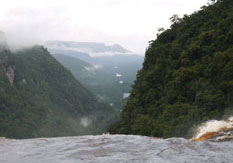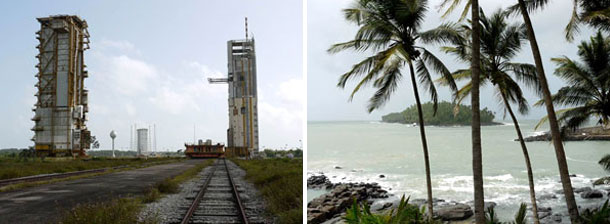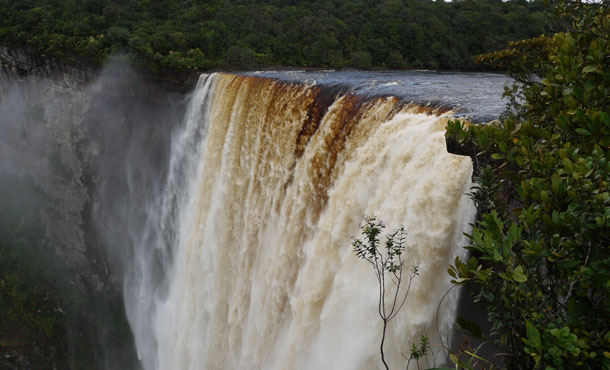Tatler - The Lost World
August 2009
Crocodiles, croissants and cricket - the three Guianas are a bewitching triumvirate. Michelle Jana Chan goes into the wild.
In so many ways, it’s a tough sell. On a map, all three Guianas -- in total about twice the size of the UK -- are wedged between Venezuela and north Brazil but are fiercely non-Latin. It’s Caribbean coastline but without a sandy beach in sight. The mighty rivers pour out Cadbury-coloured silt miles into the sea meaning mud, mangroves and brown lapping waves.
But don’t wrinkle your nose. Away from the insects, the Guianas are about to buzz. Travel’s evolving by going native, showing a shiny new face by getting filthy. Among the well-travelled there’s something embarrassing about buying Heidi Klein for a beach in the Maldives more than once a year. The holiday’s new status -- away from the old boom-time ethics -- is about going higher, further, deeper, down-and-dirtier than before.

Nowhere is more crazy and out there, more Heart of Darkness and more weird and full of misfits and mavericks than the three Guianas. And the unmissable reason to come here is big, beautiful and green: the pristine rainforest, the untameable heart of the triptych where trees know no boundary and grow like they’re saving the world. It’s noisy too. The rise and fall of cicadas sounds like Martians are landing and taking off again. The howler monkeys don’t howl at all, but sounds more like a conch shell held up to your ear or the Sirens who shipwrecked sailors. Then there are the birds -- the crass squawk of macaws, the tinamou’s haunting whistle and the cackle of caracaras. A golden-winged parakeet like tiny jangling bells and the heavy thud of a red-necked woodpecker, more axe than pecker. All this rumpus and so little to see -- but that’s the jungle for you. There might be giants living here -- anaconda, jaguar, black caiman, river otter, anteater and harpy eagle -- but they’re darn elusive. Yet nothing beats swinging in a hammock listening to the frantic pulse of forest life before it’s silenced by hard heavy rain. Zero-star accommodation is really the only way to go in the Guianas -- cold water, open-air hammocks. The recently opened Berg en Dal in Suriname is swish but service is scrappy; my favourite, Kaw Ecolodge, a new floating hotel in swampy French Guiana, is a lovely overnight escape, but still back-to-school basics.
Coming here is like meeting the cast of Cluedo. Foreign Legion colonels who cut the mustard. Reverends from Alabama telling me I too can be saved. Professors with plums in their mouths. And those are just the recent arrivals. It’s even more multicultural than Manhattan -- these three teeny countries have been traded and battled over by the British, Dutch, French and the rest. After slavery was banned, the empires imported labour from other colonies. That means half of Guyana (once British Guiana) are descendants of Indians from Chennai and Kolkata, including the current president. Cricket is obviously the national passion. Next door in Suriname (once Dutch Guiana), where shiploads of Javanese serve up the tastiest nasi goreng this side of Jakarta, 10,000 miles from the once-Dutch colony of Indonesia. “At least there are no volcanoes here”, one quipped. Finally those French. Because it is still French Guiana. So the head of state is M. Sarkozy, the currency is the euro and there are hot croissants at every corner boulangerie. Confused? It gets trickier. After everybody arrived, everybody started marrying everybody else. The kids are undefinable. I know because I’m one of them (my father is from Guyana and I have family scattered all over the rainforest).
Guyana is the most dramatic of the trio because of its colossal flat-topped mountains, wild torrents and crashing waterfalls. We motored down the Essequibo in a slender dugout and I imagined the banks closing in, as if the trees might uproot, lumber forth and shut out our only way through. The river can truly spin you out here, as it did in Kurtz’s Congo. They say that with forest this deep and dark the cutlass dulls with one slash. This land was the setting for Conan Doyle’s ‘Lost World’. And Sir Walter Raleigh tried -- and failed -- to find El Dorado. The rest of the world feels as remote as the stars. I mean, even the Rolling Stones are unknown. At a tumbledown hotel as pretty as a cupcake, I studied a bleached photograph of Mick Jagger standing in the hotel’s grounds. His shirt flapped open in a rock star kinda way. “Do you know who he is?” a waiter asked. “They say he came for the cricket.”
The isolation keeps it eccentric. You’ll find the likes of 80-year-old conservationist Diane McTurk, owner of Karanambu Lodge on the banks of the Rupununi, chic in Yves Saint Laurent silk scarves, slipping into a makeshift burrow to join her pet raccoon; an endearing Miss Mona Lisa, unable to utter a word but with a smile as serene as the oil painting’s and from a village called Km58 because it’s 58 killometres from nowhere much els; and dear Ashley, who would baffle even Henry Higgins with his Botswana-Guyana accent as he casually announces we are on the watershed of the super-sized Amazon and epic Essequibo. It’s the stuff of travellers’ dreams.
Suriname is all canals and dams and hydro-electric power. While the British wanted to map everything, the Dutch wanted to harness everything. They didn’t succeed entirely. Downriver in Awarradam, the descendants of runaway plantation slaves live in their thousands along the riverbanks. They fought for freedom, and fled. “U de no?” is the poignant daily greeting. “Are you still alive?” There’s only one reply: “U de oh” -- “We are still alive”. One wore a glorious embroidered cloak and told of how he had thirty-eight brothers and sisters. In another village, I met Orpheo, ‘a blind scoundrel’ as described by the local hard-drinking, chain-smoking Peace Corps volunteer. There was a woman with six fingers and a deaf man who could do the splits on sticks. One night, villagers gathered together to dance an ass-shaking jig and belt out songs, not about emancipation anymore but mobile phones. Rough translation of the Saramaccan lyrics: “Have you bought me a mobile? Have you topped it up yet?”

I crossed the muddy Maroni River to France, at least the bit known for Papillon’s escape and rocket launches. The town of St Laurent is so pretty-in-pink, I felt I was already having an affair. After lunch - carpaccio of St Jacques and creme brulee, of course - I visited the European Space Centre, where Ariane 5 gets slung into the stratosphere. The place makes you want to go back to school and study astrophysics, I swear. The Jupiter Room control centre looks like the setting of a James Bond film with bulky monitors and yellowing keyboards and a red button on each desk that might just destroy the world. Embarrassingly, the UK opted out of the joint venture a few decades ago meaning it’s about the only flag not fluttering here. It’s probably the most high-tech place in Europe, yet just down the road I watched a leatherback turtle lay eggs on the beach she herself had begun life on. Her eyes shimmered in the full moonlight. “We say they cry because they never get to see their babies,” a local told me.
Equally gushing is Kaieteur, a waterfall five times the height of Niagara in the heart of Guyana. From a distance, it roars like an Antonov jet engine. Where the river runneth over, there are no railings and no security guards. That’s what makes the Guianas so special. It’s just a bit dangerous in our health-and-safety world. As we flew away in the single-prop aircraft, a rainbow arched across the sky and then extended so far around it became a raincircle. Like magic. Like nature flaunting everything it’s got.





